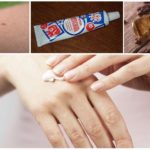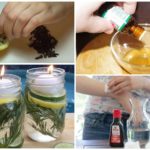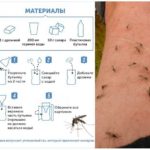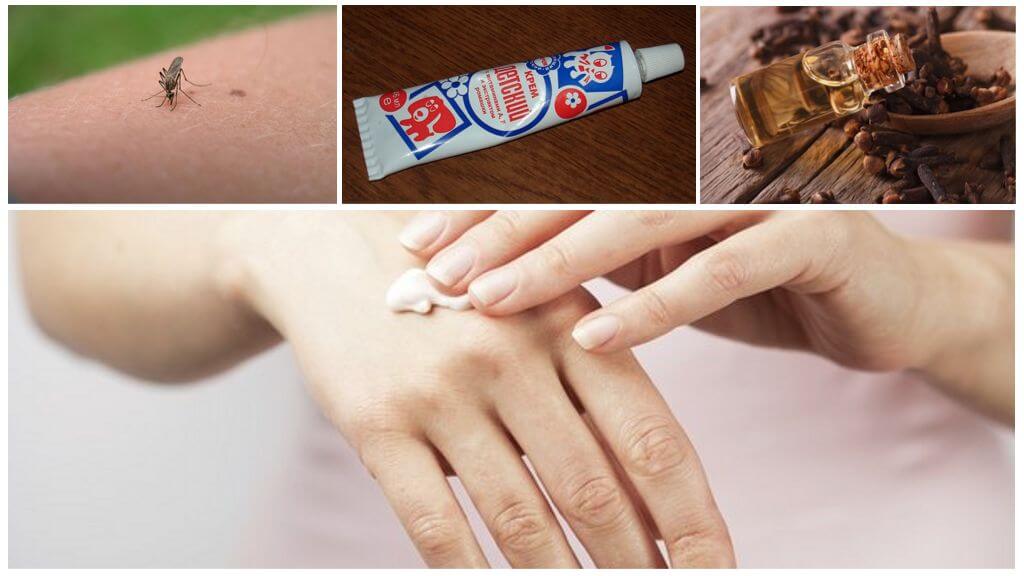Money for midges and mosquitoes with their own hands
Content
- Mosquito repellent cream with clove essential oil
- Homemade mosquito repellents
- A trap for mosquitoes with their own hands
- Aromamasla for mosquitoes
What if from mosquitoes there is no life yet industrial means for some reason there is no possibility? In this case, you should use the old folk recipes for making mixtures to scare off bloodsuckers or make traps. The production of some devices does not require any special skills or specific details. You can also make your own repeller for mosquitoes.
Homemade mosquito repellents
To homemade tools include:
- all mixtures essential oils and sprays based on them;
- creams with the addition of aroma oils or spices;
- decoctions and infusions of herbs and spices;
- homemade fumigators;
- mosquito traps.
With aromatic oils, industrial repellents are already being released. mosquito bracelets with citronella oil. Industrial capsules that need to be “stuck” on the body at night are unlikely to be copied. Their effectiveness is also low: you need 2 capsules per leg and 2 per shoulder.
An industrial bracelet with a capsule is easily replaced by a homemade one. And this option is more promising as mosquito fumigator.
How to make scare drugs
The complexity of the preparation of the mixture depends only on the willingness of the cook.The easiest way is to mix several types of aroma oils and use them later in the aroma lamp or instead of perfume. To make a mixture for the spray, you will need:
- 2 tbsp. l alcohol or vodka;
- 2 tbsp. l refined vegetable oil;
- 100 drops of aroma oil.
You can divide these 100 drops between different types of aroma oils or use some one.
All ingredients are poured into a bottle from under the perfume (spray nozzle clogged very quickly) and shake well. Spray the resulting emulsion on open areas of the body. Since the fractions do not mix with each other, the bottle should be shaken each time before use.
On a note!
The disadvantage of such "spirits" is that vegetable oil soils the clothes. But the spray is useful for use in the country or at home. Mosquitoes do not like even just oily surfaces.
Cream
The cream is made on the basis of aroma oil or vanilla powder. Most commonly used clove oil, as it has the strongest and most persistent aroma. In addition, in its pure form, this aroma oil burns the skin.
To make a remedy with clove oil, you need to take a fresh cream, squeeze it into a clean container, put a few drops of clove there and mix thoroughly. Further cream can be used as usual daily.
On a note!
Keep the cream better in the refrigerator in a closed jar.
Cream with vanilla powder they do it in the same way, but instead of a clove they take a bag of vanilla powder. Sugar does not apply.
When using creams mosquitoes will not fly up for 4 hours.
The sprays
They are best done on the basis of decoctions of aromatic herbs. There are two advantages in this: the spray gun does not clog and does not leave greasy stains. The broth can also be made from the buds of cloves, if boiled 5-10 buds in 0.5 liters of water. But since the clove produces very burning substances, this broth is more likely to require dilution. To select the dose will have to empirically depending on the sensitivity of the skin. The clove “works” for 4 hours.
“Traditional” aromatic herbs are somewhat weaker: mint, wormwood, sage, citronella, thyme - are valid from 20 minutes to 1 hour.
On a note!
The broth of wheatgrass roots has a long-term effect: 100 g of roots per 1.5 l of water.
Shampoo
They take any shampoo as a basis, adding vegetable oil and 9% vinegar to it.Before use, the product is shaken to achieve uniformity. But do not use the drug as a shampoo. A mixture of shampoo and vinegar smear open areas of the body before going out.
Scare devices
In the event of an allergic skin reaction to fragrances, even spraying clothes may be dangerous. Then you need to use a mosquito repellent device or make traps. But only under the condition that there is no allergy and odors.
In literal translation, the fumigator means "repeller." In the role of a fumigator are able to act:
- wooden or fabric decorations;
- lemon with carnation buds;
- ordinary incandescent lamp;
- tin can or chafing dish;
- aroma sticks.
The effect of such fumigators is weaker than that of industrial devices, but they can protect against mosquitoes.
Bracelets and Pendants
Most often in the role of fumigators used wooden bracelets with smoothly smoothed, but unpolished and unvarnished outer side. Aroma oil is applied to the links of the bracelet, which is well absorbed by the wood and dries slowly.Such protection lasts for several hours depending on the depth of impregnation of the links. In this case, the oil does not reach the skin.
On a note!
You can use fabric bracelets if there is no allergy. But the validity of this type of fumigator will be shorter.
Lemon
The simplest natural fumigator, not requiring special costs and skills. The lemon is cut in half, stuck carnations into halves of 10–12 buds and placed near the bed. Works all night. The next night will have to make a new one.
Incandescent lamp
A typical 40-watt incandescent lamp can replace an industrial electric fumigator. But it is difficult to call it a homemade device, as it is necessary to use it as an expendable material. industrial plates with insecticide. When using homemade cartons, paper or cloth soaked in flammable aroma oils, the risk of fire increases.
Bank or chafing dish
Pine needles smoldering in a jar, and pine cones in a roaster, effectively repel mosquitoes in nature from the company which left in the wood. But such a fumigator can not be used indoors. Carbon monoxide acts imperceptibly.
Aroma sticks
Fashionable bamboo sticks in the East with a mixture of aromatic plants applied to them can work as a fumigator indoors. But in this case, the room is filled with products of combustion.
Traps
Low-impact devices due to the mosquito’s three-level navigation system. There may be traps;
- with carbon dioxide;
- with electric lamp;
- with water.
The first two traps use mosquito's ability to find prey by the smell of carbon dioxide and heat dissipation.
With carbon dioxide
Initially, the mosquito flies on the smell of lactic acid and only a few hundred meters before the victim "switches" to the smell of carbon dioxide. At this stage, you can try to deceive and send it into a trap.
For such a trap you need:
- disposable 2-liter bottle;
- a glass of warm water;
- some yeast;
- 50 grams of sugar;
- thick sheet of paper or fabric.
The bottle is cut into unequal parts: the top is smaller. The upper part is inserted into the lower neck down to make a funnel. Sugar and yeast are poured into the bottle, and water is poured. Next, the bottle is wrapped in paper or cloth. The trap is ready.
In theory, the mosquito flies on the smell of carbon dioxide and falls into the trap. In practice, the device will have to be placed far from home, since when approaching the object, the bloodsucker switches to infrared vision and searches for prey by the amount of heat released. And the carbon dioxide trap does not generate heat.
With lamp
"At the last line of defense" there is a chance to deceive a mosquito with a stronger heat emitter in the form of a lamp. For the manufacture of traps need a large bottle and a certain knowledge in electrical engineering. The funnel at the entrance is done in the same way as in the first case. But in the bottom of the bottle cut a hole for the cartridge. The second version of the trap provides for the complete removal of the bottom for the installation of a fan, which will suck in mosquitoes into a gauze bag glued to the bottle. Mosquitoes such a trap does not kill. They will have to destroy manually.
With water
From mosquito bites does not save and is designed to reduce the insect population in the area. The results gives questionable. Initially, the workpiece is made similarly to others. But the water bottle is wrapped in a cloth so that the edges hang in the funnel. The hole in the funnel close mosquito net. The tissue is kept moist. The expectation that the eggs laid by the mosquito will fall through the net into the bottle. After turning maggots in the imago, the insect will not be able to get out of the trap.
Advantages and disadvantages
The main disadvantage of aromatic oils and blends is that they can cause allergies. If you use them in a mixture with conventional vegetable oils, then also leave stains on clothes. But high-quality aroma oils can be used instead of perfume, which is their advantage. Simplicity in use should also be attributed to pluses.
In homemade fumigators, the main problem is the fragility of action. Since when using fumigators all the same aroma oils are used, the advantages and disadvantages are the same here.
The traps are just ineffective. Even dear industrial electric traps, according to user feedback, performance is also no different.
What to use for children
For children under one year they use all the same aroma oils and decoctions of herbs that are used for adults. But the condition for the use of these drugs on babies is non-contact exposure: a cotton swab or a bottle with the tool should nottouch the baby’s skin.
For older children apply cream with vanilla powder or wheatgrass broth. If folk recipes have not helped the child, it is worth exploring the assortment of pharmaceutical preparations, among which there are funds for crumbs up to a year and anti-mosquito products for children over the year.
On the street or in the house?
Some of the homemade tools are more effective in the house, others on the street. A roasting pan or incense sticks are best used outside, although the sticks are also suitable for indoor use. Traps are also better to put on the street "on approach". Once in the house, the mosquito is unlikely to confuse a person with a trap.
Aroma oils are suitable both for the street, and for the house. Indoors methods of their use more.
Conclusion
Choose a method of protection against mosquitoes need, based on the reaction of their own body. Someone well suited essential oils. In others, they cause an allergic reaction, and such people are better to use herbal decoctions or fumigators. But to find out what best suits a particular person, you can only experimentally.













